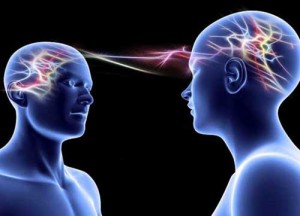Like many mothers who feared for their family’s safety during World War II, Mona Miller was evacuated from London to the peaceful seaside town of Babbacombe in Devon. It seemed like a wise precaution but, shortly after her arrival there with her young children, Mrs Miller became increasingly uneasy.
“I had a feeling that I must leave Devon and return home,” she told me. “At first I dismissed the idea; why leave when I was so happy and contented despite the war going on around me? But the feeling increased. The walls of my room seemed to speak to me: ‘Go home to London.’ I resisted the call for about four months then, one day, like a flash of light, I knew we must leave.”
‘On a Saturday in late 1942, we travelled back to London and a few days later I received a letter from a friend in Devon. ‘Thank God you took the children on Saturday’, she wrote. Early Sunday morning, Jerry dropped three bombs and one fell on the house where you were living, demolishing it, and killing all the neighbours on either side.”
Mrs Miller was far from the only person to experience such forebodings during the war. Three years later, in the spring of 1945, U.S. serviceman Charles Bernuth took part in the invasion of Germany and, shortly after crossing the Rhine, found himself driving along the autobahn one night with two officers. He described how a ‘still, small voice’ within him told him there was something wrong with the road ahead.
“I stopped, amid the groans and jeers of the other two. I started walking along the road. About 50 yards from where I had left the jeep, I found out what was wrong. We were about to go over a bridge — only the bridge wasn’t there. It had been blown up and there was a sheer drop of about 75ft.”
Both Mrs Miller and Charles Bernuth had experienced presentiments — feelings that something was going to happen without knowing what it would be. These differ from premonitions, where the person involved has an insight into what lies ahead — like when 16-year-old Carole Davies visited a London amusement arcade during the Seventies.
“While standing looking out into the night, I had a sense of danger,” she recalled. “Then I saw what looked like a picture in front of me showing people on the floor with tiles and metal girders on them. I realised that this was to happen here. I began to shout at people to get out. No one listened.”
Together with her friends, Carole hurried out and went to a nearby cafe. As they sat inside, they heard sirens in the street outside. A weakness in the arcade building’s structure had brought its roof and walls crashing down on those within.
“We all ran down the road to see what had happened,” Carole remembered. “It was just as I had seen. A man I had shouted at was being pulled from under the debris.”
We need to look far beyond the traditional scientific view that everything is essentially material or physical, including the human mind.
Like Mona Miller and Charles Bernuth before her, Carole was convinced she owed her life to her mysterious sixth sense, a notion which you might expect a scientist of my background to dismiss out of hand. I am a biologist who has studied, researched and taught at both Cambridge and Harvard, and held senior academic posts on both sides of the Atlantic. Yet I’ve long believed that presentiments, premonitions and other psychic phenomena such as telepathy should be taken more seriously by my scientific colleagues.
My fascination with this subject began during the Sixties when I was a graduate student in the biochemistry department at Cambridge University. This was not long after the South African writer Laurens van der Post had published his accounts of life with the Bushmen of the Kalahari desert. Like most traditional societies, theirs was one in which telepathy was not only taken for granted, but put to practical use, as van der Post saw when his hosts hunted down and killed an eland antelope many miles from camp. As they were driving back in a Land Rover laden with meat, he asked one of the Bushmen how those back at camp would react when they learned of this success.
“They already know — we Bushmen have a wire here,” he replied, tapping his chest. “It brings us news.” He was comparing their method of communication with the white man’s telegram or ‘wire’.
Sure enough, when they approached the camp, the people were singing the ‘Eland Song’ and preparing to give the hunters the greatest of welcomes.
Many other travellers in Africa have reported that people seemed to know when loved ones were coming home. The same would occur in rural Norway, where the inhabitants developed a special word — vardoger — for the anticipation of arrivals. Similarly, accounts I read of the ‘second sight’ of some inhabitants of the Scottish Highlands included visions of arrivals before the person in question appeared.
But none of this convinced me, converted as I was to the dogma of ‘materialism’ which has dominated scientific thought since the late 19th century, and still does so today.
According to materialists, science will eventually explain everything in terms of physics and chemistry. And anything that cannot be thus explained can be dismissed as illusory.
Educated in this tradition, I adopted the standard dismissive attitude when the subject of telepathy came up in the laboratory tearoom one day. I was gently taken to task by Sir Rudolph Peters, one of the doyens of British biochemistry. He was a kindly man with twinkly eyes and more curiosity than most people half his age. He told me of an ophthalmologist friend who had a severely disabled and mentally retarded young boy as a patient. Although he was almost blind, he seemed able to read the letters on the optician’s chart very well, but only when his mother was looking at them.
The only explanation appeared to be some form of telepathic communication between the two, and in 1968 Sir Rudolph conducted an experiment in which the boy correctly guessed many of the written numbers or words shown to his mother, even though they were sitting on either side of a screen which prevented him from picking up any visual or auditory cues.
Sir Rudolph concluded that this telepathy had developed to an unusual degree because of the boy’s extreme needs and his mother’s desire to help him. But, as I discovered, even laboratory experiments involving strangers had produced results which, if less marked, were still compelling.
For example, the years between 1880 and 1939 saw something of a boom in early psychical research, with the publication of more than 186 studies involving trials in which subjects guessed which randomly selected cards a ‘sender’ was looking at. When the four million individual results were combined in a statistical procedure called meta-analysis, the overall results were hugely significant because they were considerably more accurate than would have been expected from random chance.
Later experiments during the Seventies involved subjects sleeping in a soundproofed laboratory while a ‘sender’ in another room, and in some cases another building, opened a sealed package containing a randomly selected picture and concentrated on it, trying to influence the subject’s dream.
Sometimes the thought transference was very clear: one subject described having dreamed about buying tickets for a prize fight while the sender was looking at a picture of a boxing match. Occasionally, it was more symbolic, as when the subject dreamed of a dead rat in a cigar box while the sender was looking at a picture of a dead gangster in a coffin. But in 450 such trials the overall results were very significantly above the chance level.
My research has included more than 4,000 cases of psychic phenomena. Many, like Mona Miller’s near-miss in the Blitz, involve mothers. Hundreds told me that during the months they were breastfeeding, they’d know when their baby needed them, even from miles away, because they began secreting breast milk. So, with the help of a midwife, I studied nine nursing mothers in North London during a two-month period, and found that their unexpected ‘let-downs’ of milk when they were separated from their babies very often coincided with their infants experiencing distress. The odds against this occurring by chance as often as it did were a billion to one, and this telepathic connection makes good evolutionary sense.
Mothers who could tell at a distance when their babies were unhappy would tend to have babies that survived better than those of insensitive mothers. Such connections often seem to continue even when the children have grown up, with many stories on my database concerning mothers who had an urge to get in touch with their children when they could not have known by any conventional means that they were in trouble. Many would do so by telephone, the method of communication most commonly mentioned in reports of telepathic experiences in general.
Many people told me they had thought of someone for no apparent reason, and then that person rang in a way that seemed uncanny. Or they knew who was calling when the phone rang, even before they picked up the receiver.
I designed an experiment to test this, a simplified version of which you can try through my website. This involved asking subjects for the names and phone numbers of four friends or family members before placing them alone in a room with a landline telephone with no caller ID. I then selected one of the four callers at random and asked them to phone the subject, who had to say who was on the line before answering.
By guessing at random, subjects would have been right about one time in four, or 25 per cent. In fact, the average hit rate was 45 per cent, very significantly above the level of chance, and these results have been replicated independently at universities in Germany and Holland.
In attempting to explain such phenomena, we need to look far beyond the traditional scientific view that everything is essentially material or physical, including the human mind.
That materialist approach was summed up by Francis Crick, who in 1962 shared a Nobel Prize for the discovery of the structure of DNA. “You, your joys and your sorrows, your memories and your ambitions, your sense of personal identity and free will, are in fact no more than the behaviour of a vast assembly of nerve cells and their associated molecules,” he wrote.
Crick spoke for the scientific mainstream, as did influential neuroscientist Susan Greenfield when she described seeing an exposed brain in an operating theatre. “This is all there was to (the patient) Sarah, or indeed to any of us,” she reflected in a paper published in 2000. “We are but sludgy brains and somehow a character and mind are generated in this soupy mess.”
Yet this idea that our minds are fixed physically inside our heads, and that consciousness is nothing but a by-product of the activity of the brain, runs contrary to our everyday experience. When we look around us, the images of the things we see are outside us, not in our heads. The feelings in my fingers are in my fingers, not in my head.
The human intuitions I have described fit better with the ‘field theory’ of minds. We are used to the fact that fields exist both within and outside material objects such as magnets and mobile phones, and there is reason to believe that our minds have similar fields which have their roots within our brains, but also extend beyond them.
Extraordinary though this sounds, it’s supported by studies of another remarkable psychic phenomenon — the sense of being stared at. Most people have felt someone looking at them from behind, turned around and met the person’s eyes. And most people have experienced the converse: making someone turn around by staring at them. In extensive surveys in Europe and North America, between 70 and 97 per cent of adults and children reported such experiences. In a series of interviews with police officers, surveillance personnel and soldiers, I discovered most felt that some people seemed to know they were being observed, even though the watchers were well hidden.
“A lot of times the crook will just get a feeling that things aren’t right,” I was told by one narcotics officer. “We often have someone look right in our direction even though he can’t see us. A lot of times we’re inside a vehicle.”
Surprisingly, laboratory tests have shown that the sense of being stared at works even when people are looked at on screens, rather than directly. Our emotional response can be measured by the activity of our sweat glands and this increases in many subjects being watched on CCTV, even though they are unaware of their response. All this suggests that, whether through direct staring or CCTV, we are capable of ‘touching’ each other with our sight — further evidence that our minds are not confined to the inside of our brains.
With telepathic communication, it seems that these fields somehow interact at a distance, picking up feelings, needs or thoughts across space.
As for presentiments and premonitions, these imply links across time, as we tune into our future mental states.
That such links are real was suggested by a series of experiments in the U.S. and Holland over the past 20 years. These measured responses to a series of noxious smells, mild electric shocks, emotive words and provocative photographs, interspersed with calming stimuli which had no physiological effect on subjects at all. No one, not even the experimenters, knew what kind of stimuli the computer involved would produce next, but in a significant number of cases the subjects reacted to the unpleasant stimuli some three or four seconds in advance, somehow connecting with their future selves who would be experiencing the stimuli for real.
These findings are fascinating in themselves but, as I will explain in further work, psychic phenomena are not restricted to human beings. There are amazing stories of telepathy and premonitions of disaster in many other species, including pet dogs.
As for exactly how such phenomena operate, it may be years before we understand them, but an important first step is for scientists to acknowledge that they exist, and that the minds of both animals and humans interact in as yet unexplained ways.
Source:
About the author:
 Rupert Sheldrake, one of the world’s most innovative biologists and writers, is best known for his theory of morphic fields and morphic resonance, which leads to a vision of a living, developing universe with its own inherent memory. He worked in developmental biology at Cambridge University, where he was a Fellow of Clare College. He was then Principal Plant Physiologist at the International Crops Research Institute for the Semi-Arid Tropics (ICRISAT), in Hyderabad, India. From 2005 to 2010 he was Director of the Perrott-Warrick project, funded from Trinity College, Cambridge. You can read Rupert Sheldrake’s full biography here.
Rupert Sheldrake, one of the world’s most innovative biologists and writers, is best known for his theory of morphic fields and morphic resonance, which leads to a vision of a living, developing universe with its own inherent memory. He worked in developmental biology at Cambridge University, where he was a Fellow of Clare College. He was then Principal Plant Physiologist at the International Crops Research Institute for the Semi-Arid Tropics (ICRISAT), in Hyderabad, India. From 2005 to 2010 he was Director of the Perrott-Warrick project, funded from Trinity College, Cambridge. You can read Rupert Sheldrake’s full biography here.

If you've ever found value in our articles, we'd greatly appreciate your support by purchasing Mindful Meditation Techniques for Kids - A Practical Guide for Adults to Empower Kids with the Gift of Inner Peace and Resilience for Life.
In the spirit of mindfulness, we encourage you to choose the paperback version. Delve into its pages away from screen glare and notifications, allowing yourself to fully immerse in the transformative practices within. The physical book enriches the learning process and serves as a tangible commitment to mindfulness, easily shared among family and friends.
Over the past few years, Wake Up World has faced significant online censorship, impacting our financial ability to stay online. Instead of soliciting donations, we're exploring win-win solutions with our readers to remain financially viable. Moving into book publishing, we hope to secure ongoing funds to continue our mission. With over 8,500 articles published in the past 13 years, we are committed to keeping our content free and accessible to everyone, without resorting to a paywall.








